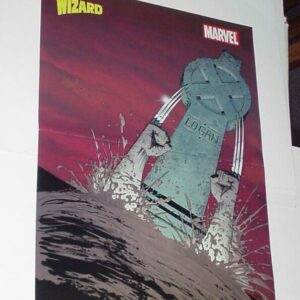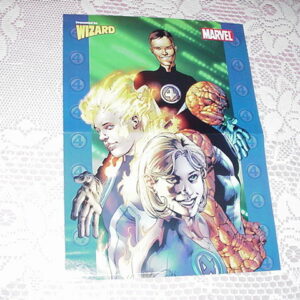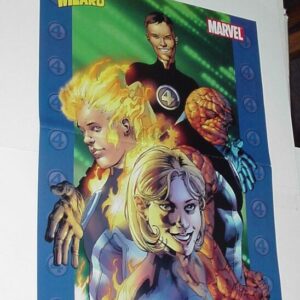Batman Poster #28 FRAMED Joker The Killing Joke (1988) by Brian Bolland
$99.99
Description
You are purchasing the item pictured, framed. Priority mail, tracking and $50 insurance is included with purchase. Item will be bagged to protect from dust, packed in packing peanuts and boxed. Just open box and hang it on the wall…makes a perfect gift!
Although they’d been around for decades, the term “graphic novel” was just coming into vogue when DC published the one-shot, prestige format trade paperback Batman: The Killing Joke in 1988. A tense psychological battle of wills between the Dark Knight and his most bitter adversary – with a fresh take on the Joker origin story embedded inside it – The Killing Joke helped raise the bar on adult themes in mainstream super-hero comics. The Joker’s brutal gun-down of Barabara Gordon (aka Batgirl) is only the most shocking moment in this Alan Moore-penned tale, which had serious repercussions for Batman continuity and laid the groundwork for all future interpretations of the Clown Prince of Crime, including both Tim Burton’s and Christopher Nolan’s. About the only person not totaly floored by The Killing Joke’s power was artist Brian Bolland, who found Moore’s story underwhelming and detested the “garish” hues chosen by colorist John Higgins. Bolland would later recolor the entire book himself for the 20th anniversary edition. “Covers are a safe place for me. If someone else’s colors swamp my work, then who cares. It was only one page. I can move on to the next one.”- Brian Bolland. Batman: The Killing Joke is a one-shot superhero graphic novel written by Alan Moore and drawn by Brian Bolland. Published by DC Comics in 1988, it has remained in print since then, and has also been reprinted as part of the trade paperback DC Universe: The Stories of Alan Moore. The story’s effects on the mainstream Batman continuity included the shooting and paralysis of Barbara Gordon (a.k.a. Batgirl) by the Joker, an event that laid the groundwork for her to develop the identity of Oracle, an expert computer hacker and a vital source of information for Batman and other superheroes (though Barbara’s paralysis would be healed with the 2011 initiative The New 52). Hilary Goldstein of IGN Comics praised The Killing Joke, calling it “easily the greatest Joker story ever told,” and adding that “Moore’s rhythmic dialogue and Bolland’s organic art create a unique story often mimicked but never matched.” IGN declared The Killing Joke the third-greatest Batman graphic novel, after The Dark Knight Returns and Batman: Year One. In a 2006 interview with Wizard magazine, Moore was also critical about his decision to cripple Barbara Gordon: “I asked DC if they had any problem with me crippling Barbara Gordon – who was Batgirl at the time – and if I remember, I spoke to Len Wein, who was our editor on the project…He said, ‘Yeah, okay, cripple the bitch.’ It was probably one of the areas where they should’ve reined me in, but they didn’t.” Tim Burton has mentioned that The Killing Joke influenced his film adaptation of Batman: “I was never a giant comic book fan, but I’ve always loved the image of Batman and The Joker. The reason I’ve never been a comic book fan — and I think it started when I was a child — is because I could never tell which box I was supposed to read. I don’t know if it was dyslexia or whatever, but that’s why I loved The Killing Joke, because for the first time I could tell which one to read. It’s my favorite. It’s the first comic I’ve ever loved. And the success of those graphic novels made our ideas more acceptable.” Director Christopher Nolan has mentioned that The Killing Joke served as an influence for the version of the Joker appearing in the 2008 feature film The Dark Knight. Heath Ledger, who played the Joker, stated in an interview that he was given a copy of The Killing Joke as reference for the role. The 2009 video game Batman: Arkham Asylum adapted a post-The Killing Joke timeline, in that Barbara Gordon feeds Batman information as Oracle. Several references to the story are also made in the game. The Joker’s makeshift throne made of mannequins at the end of the game is almost identical to the one in the graphic novel. During the game, it is revealed that the Joker had been using e-mail under the alias “Jack White,” which Batman identifies as “one of Joker’s oldest aliases.” The Joker even personally makes a knowing reference to the story: “There were these two guys in a lunatic asylum… Oh hell, you’ve heard that one before, haven’t you?” Brian Bolland (born 1951) is a British comics artist. Best known in the UK as one of the definitive Judge Dredd artists for British comics anthology 2000 AD, he spearheaded the ‘British Invasion’ of the American comics industry, and in 1982 produced the artwork on Camelot 3000 (with author Mike W. Barr), which was DC’s first 12-issue comicbook maxiseries created for the direct market. His rare forays into interior art also include Batman: The Killing Joke, with UK-based writer Alan Moore, and a self-penned Batman: Black and White story. Bolland remains in high demand a cover artist, producing the vast majority of his work for DC Comics. Bolland drew a pinup for Superman #400 (Oct. 1984) and its companion portfolio. In 1986, Bolland was one of several artists who contributed pages to the anniversary issue Batman #400 (Oct, 1986), his offering featuring villains Ra’s Al Ghul and Catwoman. Around this time, Titan Books were “trying to launch a line of comics all written by Alan Moore,” and “talks were underway to do a Batman Meets Judge Dredd one-off by Alan and me.” With these ideas kicking around in his head, and when “it became clear that Camelot 3000 had sold reasonably well,” DC editor Dick Giordano then asked Bolland what project he wanted to work on next. Bolland says: “I thought about it in terms of who’s my favourite writer at the moment, what hero I would really love to do, and which villain? I basically came up with Alan, Batman and the Joker.” The result was the popular, influential and controversial Batman: The Killing Joke, first published in 1988. Giordano’s invitation led directly to Bolland working with writer Alan Moore to create a plausible background story for the premier Batman villain, the Joker. Bolland’s Joker fascination stemmed in part from his having “recently seen the excellent silent movie The Man Who Laughs,” and he therefore wanted to do a “Joker story with the Batman as a more distant, peripheral character.” Although the story takes pains to stress that it is merely one possible ‘origin story,’ it has been widely accepted and adopted into DC continuity, and a central mutilation of a long-running character had to be specially approved by editor Wein. Bolland notes that he saw “Judge Death almost a dry run for drawing the Joker,” but that this artistic similarity did not proclude difficulties setting in during the genesis of TKJ as “by the time Alan had finished Watchmen he had fallen out with DC to a certain extent… in the end, he only continued to do Killing Joke as a favour to me.” In 1989, Moore and Bolland’s The Killing Joke received an Eisner Award for “Best Graphic Album,” while Bolland was named separately as “Best Artist/Penciller/Inker” for the same work. The same year, Bolland won three Harvey Awards; two in the same categories for the same work – “Best Artist” and “Best Graphic Album” – while the third was also The Killing Joke which was separately honoured as the winner of the “Best Single Issue” award.
>PAN>Frame is shrinkwrapped until time of purchase. Ships boxed with packing peanuts.
THE PERFECT GIFT!
Related products
-


Wolverine Poster #13 Lives! by John Cassaday X-Men
$34.99 Add to cart -


X-Men Poster #36 Mystique Joseph Michael Linsner Dawn
$34.99 Add to cart -


Ultimate Fantastic Four Poster # 1 Bryan Hitch Reed Johnny Sue Ben
$39.99 Add to cart -


Ultimate Spider-Man Thing Wolverine Poster David Finch X-Men Fantastic Four
$29.99 Add to cart




